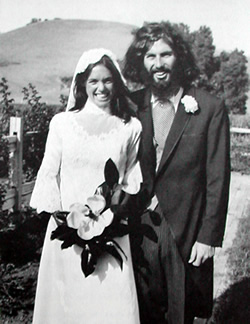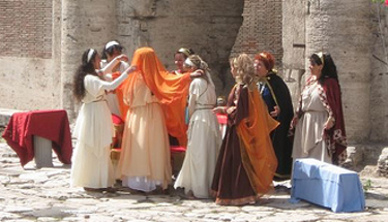ANCIENT TIMES
Three major wedding traditions can be traced back thousands of years, starting with that symbol of eternity and everlasting love: the wedding ring. In ancient Egypt, a band of hemp or rush (a leafless, grasslike plant) was worn on the third finger of the left hand, as it was believed that the vein in this finger led directly to the heart.
| Hemp Ring, contemporary |
You can thank the Romans for both your bridal party and your veil. Bridesmaids and groomsmen originally served as protection against jealous demons that were out to get the to-be-weds, while it was thought that a veil protected the bride from evil spirits. (The tradition of the veil has other possible origins, but this is one of the earliest mentions of it.)
MIDDLE AGES
It was considered good luck for guests at medieval weddings to tear off and take a piece of the bride's dress. To distract them from grabbing, brides began throwing their flowers, literally launching the bouquet toss.
The custom of a boutonniere caught on around the same time, when a knight would proudly display his bride's "colors" on his chest as a statement of his love.
 | ||
| "God Speed!" (1900) -- Edmund Leighton |
THE RENAISSANCE
The Renaissance ushered in diamond rings, which became synonymous with engagements when Archduke Maximilian of Austria gave one to Mary of Burgundy in 1477.
 | ||
| Archduke Maximilian & Mary of Burgundy |
Today's traditional vows were first widely used by the Anglican Church in the 16th century, and European nobility of the 17th century brought favors -- originally a box of confections called bonbonnieres -- into fashion.
VICTORIAN DAYS
Trendsetting Queen Victoria inspired several modern-day traditions, including the white wedding dress. After her nuptials to Prince Albert, wearing white became the norm (before that, donning color was the thing to do), and a million couture fantasies were born as fashion became accessible to the average gal.
 | ||
| When Queen Victoria married her cousin Albert on February 11, 1840 at the royal chapel of St. James, she wore a white satin dress. |
Queen Victoria also introduced the idea of carrying fresh flowers in the bouquet -- prior to that, brides followed the Greco-Roman tradition of holding herbs and spices to ward off evil spirits. The queen's offspring had a great influence on society, too... After daughter Princess Victoria played Richard Wagner's "Bridal March" at her wedding to Friedrich III of Germany, the song (from the opera Lohengrin) became the go-to tune for walking down the aisle. And though a French chef in the 16th century is often credited with the towering tiers we now know as wedding cake, son Prince Leopold, Duke of Albany, served the first entirely edible cake at his nuptials. Before that, many layers were faked and made of pure sugar.
ART DECO ERA
With new innovations in art and design, brides of the 1920s and 1930s were becoming more savvy, and the trends began to reflect this change. Marshall Field's department store in Chicago originated the bridal registry to help stylish newlyweds select their chosen china, silver and crystal patterns, and alert their family and friends. Then, in the mid-1940s, the end of WWII and the safe homecoming of millions of soldiers resulted in a postwar wedding boom. That, along with the birth of more portable cameras and lighting equipment, made professional photography a key part of weddings.
 | |||
| The Wedding Bureau on the 2nd Floor of Marshall Field's in Chicago, 1946... the registry was started in 1924. |
POSTWAR
In the 1940s and 1950s, classic style took center stage. Actress Grace Kelly's elaborate fairy-tale wedding to Prince Rainier III of Monaco launched a million princess-bride fantasies, and formal white weddings and lace gowns became the pinnacle of chic.
 |
| Princess Grace, 4/19/56 |
Meanwhile, having taken control of most of the world's diamond mines, De Beers used a postwar marketing campaign and brilliant slogan to turn a diamond solitaire into the quintessential symbol of love. These timeless trends still hold up decades later.
 |
| Frances Gerety
wrote "A Diamond is Forever" for an advertising campaign for De Beers
in 1947, and wrote all of the company's ads for years. |
THE DISCO-TO-DECADENCE DECADES
As times and fashions rapidly changed, rebellious couples of the 1970s rejected the cookie-cutter weddings of the '50s. Looking for alternative ways to exchange their vows, free-spirited brides and grooms headed off to far-flung locales (either alone or with just a small group of people) and the destination wedding was born. Fashion followed suit with statement-making brides opting for alternative styles like minidresses, caftans, Mexican wedding dresses and even disco-inspired white pantsuits. The growing popularity of synthetic fabrics like polyester mid-decade also served to alter styles.
 |
| Bianca Pérez-Mora Macias & Mick Jagger, 5/13/71 |
 |
| Edie Sedgwick & Michael Post, 7/24/71 |
When the 1980s rolled around, royal wedding fever swept the states. In the wee hours of the morning on July 29, 1981, all eyes turned to watch Princess Diana walk down the aisle at St. Paul's Cathedral toward Prince Charles. Taking a fashion cue from across the pond, designers made puffy sleeves, big bows and over-the-top dress details the height of bridal chic.
 |
| Princess Diana's Wedding Dress |
THE DIGITAL AGE
In keeping with the '90s technology boom, the dot-com bride was born. Wedding planning went online, and Target became one of the first retailers to introduce electronic self-service registries. On the fashion front, ladies began to go bold. Sarah Jessica Parker bucked tradition by marrying Matthew Broderick in a little black dress, as did Gwen Stefani by donning an ombre pink hue, while Carolyn Bessette ushered in a modern bridal look by wearing a sleek sheath and a simple chignon.
 | ||
| Sarah Jessica Parker & Matthew Broderick, 5/19/97 |
 |
| Gwen Stefani, 9/14/02 |
 |
| JFK Jr & Carolyn Bessette, 9/21/96 |
THE REIGN OF REALITY
At the dawn of the new millennium, weddings invaded pop culture, and TiVos filled with bridal-obsessed fare. To start it off, The Bachelorette's Trista and Ryan Sutter starred in a $4 million TV wedding, sparking the bridal reality show that made Randy Fenoli a household name and introduced the nation to the "Bridezilla". MTV's Newlyweds: Nick and Jessica ruled the airwaves, with her wedding dress setting the bridal standard in the '00s.
 |
| Jessica Simpson & Nick Lachey, 10/26/02 |
In April 2011, more than 2 billion people flocked to TVs, laptops, and iPhones to watch the world's ultimate reality show -- the long-awaited royal wedding of Will and Kate. Lace sleeves immediately ruled the runways, the style becoming a top contestant against the strong-selling strapless sweetheart-bust gown made popular by Simpson a decade earlier.
 |
| Prince William and Kate Middleton, 4/29/11 |
TODAY
Your day, your way! From DIY details and bold, colored accessories to bizarre menus and unconventional venues, today's brides are veering from tradition more than ever before. Couples are now aiming to create events as individual as they are.
ONCE UPON A TIME...
These traditions are so old, no one even knows when they began:
- Before giving away the bride was a symbolic gesture, she was literally given to the groom by her father in exchange for property. Surprisingly, it was the Romans who introduced the idea of a woman's consent to marriage.
- The "honeymoon" is thought to perhaps date back to ancient Celtic cultures, when newlyweds would drink honey wine (mead) to increase fertility. In contrast, the Merriam-Webster dictionary reports the etymology as from "the idea that the first month of marriage is the sweetest" (1546).
- In the early days of arranged marriages, the bride and groom didn't lay eyes on each other until the wedding ceremony.
- Before photo booths and fingerprints, a simple signature was all that was needed for a guest book. In fact, everyone who attended a wedding was considered a witness and, therefore, required to sign the marriage document.
- During the ceremony, the guests would make loud noises to keep evil spirits away. Now, the bridal party honks their car horns and attaches rattling tin cans to the duo's getaway ride.
- Every wonder what cake has to do with getting married? The wedding cake originated from an ancient custom in which a loaf of bread was broken over the bride's head and guests shared the crumbs, which symbolized fortune and fertility.
- In bygone days, the bride would stand to the groom's left during a Christian ceremony because the groom needed his right hand free to fight off other approaching suitors.
For source material and further reading, please explore The Knot.



.jpg)



